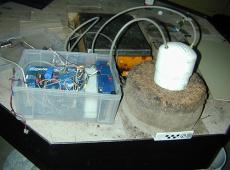Research linking fire and soils is multifaceted and the diversity of studies conducted in our lab reflects the interrelationships between many resources in the fire environment. While immediate concerns are often focused on soil properties, biology, nutrients and plant mortality, other important concerns relate to resources associated with soils or the transfer of heat into the soil from sources other than the flaming combustion of woody fuels.
Casual observation of wildfires leads one to believe that soil heating is largely associated with high intensity of the flaming combustion zone. Laboratory burning of crude oil on the soil surface showed that a low percentage of the heat generated during burning is actually transferred downward into the soil. In contrast with the temperatures found in the flaming combustion zone, temperatures associated with smoldering duff and organic soil are lower but the duration of smoldering is significantly longer than the relatively short duration of the passing flame front. The smoldering combustion of organic soil materials or rotten logs in contact with the soil results in higher soil temperatures than radiant heating from the flame zone.
Our understanding of soil heating was improved using intact mineral and organic soil cores. These cores were burned under controlled conditions to simulate the effects of flaming and smoldering combustion. The soil heating model that is currently implemented in FOFEM and other models delineating the soil moisture limits of smoldering combustion in organic soil and forest floor duff were developed from the results of this work.
Cultural artifacts and paleontological resources are often buried within the soil and are effected by the transfer of heat from flaming and smoldering combustion. In contrast, artifacts and fossils may be present on the on the soil surface and are exposed to heat from flaming combustion. Although these resources are not typically consumed during burning there maybe physical damage and low temperatures on their surfaces may destroy or obscure delicate markings that are used to interpret their significance.
A range of instrumentation was used to link this laboratory work with field conditions to better recognize prescribed fire burning opportunities and potential wildfire conditions. Soil moisture is an important variable that effects heat transfer and smoldering combustion. It is highly variable and time consuming to collect. Soil moisture and other variables were monitored using stand-alone data loggers at easily accessible sites, while cellular and satellite sensor platforms were used to provide timely data from inaccessible sites.
